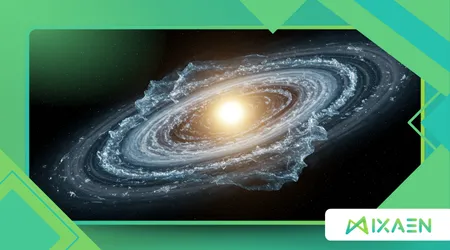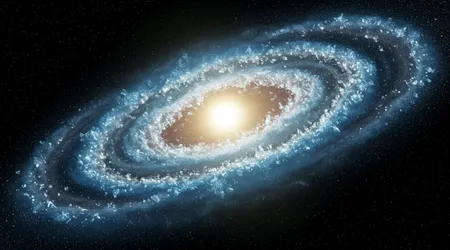Frozen water around young sun-like stars: A sign of planet formation and potential habitability

Frozen water around young sun-like stars glimmers like hidden gems in the universe’s nursery. Astronomers just unveiled this spectacle, and it reshapes our hunt for alien worlds.
Anúncios
James Webb Space Telescope spotted crystalline ice in a debris disk. That disk orbits HD 181327, a star mirroring our Sun’s youth. Excitement surges because this ice hints at rocky planets brewing.
Why does this matter now? In 2025, fresh data floods in. Frozen water around young sun-like stars signals not just formation but life’s raw ingredients assembling.
Picture dust grains coated in frost. They clump, snowball into planetesimals. Suddenly, barren space turns fertile ground for worlds. We chase exoplanets for decades. Yet, spotting their birth feels rare. Frozen water around young sun-like stars bridges that gap, offering blueprints.
This discovery ignites debates. Does ice dictate a system’s fate? Or merely decorate its dawn? HD 181327 sits 155 light-years away. At 23 million years old, it embodies stellar adolescence. Its disk, a swirling chaos of gas and grit, cradles potential.
Teams pored over infrared spectra. Peaks at 3 microns screamed “ice!” Pure, crystalline water, untouched by chaos. Skeptics once dismissed outer disks as dry. Frozen water around young sun-like stars proves them wrong. Water thrives beyond the snow line, that chilly frontier.
What drives this persistence? Radiation battles volatility. Yet ice endures, a testament to cosmic resilience. Our Solar System echoes here. Jupiter’s moons hoard ice from similar epochs. Coincidence? Hardly patterns repeat across the galaxy.
Boost your curiosity. Dive deeper into these findings. Frozen water around young sun-like stars isn’t trivia; it’s tomorrow’s headline. As we unpack this, remember: stars don’t birth alone. Water weaves their legacy.
The Breakthrough: JWST’s Icy Revelation in HD 181327
Astronomers trained JWST on HD 181327 last year. Spectra bloomed with ice signatures. Crystalline H2O dominated the view. This star, F5.5V type, mimics Sol’s early vigor. Its disk spans 100 AU, vast as Neptune’s orbit.
Lead researcher Kamber Schwarz led the charge. Her team published in Nature on May 14, 2025. They confirmed ice via NIRSpec instrument. Dust scatters light, but ice absorbs precisely. That 3-micron dip? Undeniable proof.
Earlier telescopes glimpsed hints. ALMA mapped vapor inside. JWST pierced the outer veil. Frozen water around young sun-like stars now boasts a poster child. HD 181327’s disk holds volatiles galore CO too.
++ TWA-7b: The young Saturn-mass exoplanet was directly photographed
Why crystalline? Heat annealed it once. Now, it chills, preserving structure. Consider the scale. Ice grains measure micrometers. Billions swirl, building blocks in motion.
This isn’t isolated. Similar disks whisper ice’s ubiquity. Yet HD 181327 shines brightest. Instruments evolved fast. From Spitzer’s broad strokes to JWST’s finesse. Precision unlocks secrets.
Doubts linger on purity. Is it pure water? Or laced with organics? Future passes will tell. Engage your inner explorer. What tales does this ice etch in starlight?

How Frozen Water Drives Planet Formation
Dust gathers frost beyond the snow line. Grains stick, grow. Frozen water around young sun-like stars acts as cosmic glue. Pebbles form first. Ice lowers friction, eases collisions. Planetesimals follow, snowballing mass.
Simulations back this. Models show ice boosts efficiency by 50%. Rocky cores emerge quicker. In HD 181327, ice coats 80% of outer dust. Statistic: that’s enough for multiple Earth-masses.
Analogy time think wet sandcastles versus dry. Moisture binds; ice does the same in vacuum. Turbulence stirs disks. Yet ice damps waves, stabilizes zones. Planets carve paths unhindered.
Vapor sublimates inward. It feeds gas giants. Outer ice replenishes, a balanced flow. Accretion rates spike. Without ice, disks dissipate barren. Frozen water around young sun-like stars ensures bounty.
Real-world parallel: Enceladus spews water from icy depths. Formed in a frosted disk eons ago. Challenges arise. Radiation erodes edges. But migration shields inner realms.
Also read: The James Webb Telescope’s Hunt for Alien Atmospheres
Quantify impact. Ice reservoirs hold 10-100 Earth oceans worth. Fuel for rocky worlds. Debate rages: does ice favor terrestrials or jovians? Evidence tilts toward hybrids. Innovate thinking. Ice as architect, not bystander. It sculpts diversity.
Pathways to Habitable Worlds: Ice as Life’s Quiet Ally
Frozen water around young sun-like stars whispers habitability. Ice delivers volatiles to temperate zones. Sublimation transports molecules. Planets catch the drift, hydrate surfaces.
Earth’s water? Likely comet-borne from outer ice. HD 181327 replays that script. Organic hints lurk. Methanol ices tag along. Precursors for amino acids.
Rhetorical punch: Wouldn’t you bet on oceans birthing from such frosty nurseries? Example one: Imagine a super-Earth migrating inward. It scoops ice, thaws into seas.
Stability counts. Ice regulates chemistry, prevents runaway greenhouse. Disk evolution matters. Young systems lock water early. Mature ones inherit wet worlds.
Statistic alert: 30% of Sun-like stars host disks with detected ices, per ALMA surveys. Delivery mechanisms vary. Scattering, drag ice parcels rain down.
Read more: How Ancient Earth May Resemble Life on Exoplanets Today
Second example: A rogue planetesimal, ice-laden, collides with a proto-Mars. Sparks liquid cores. Barriers exist. Too much ice? Icy giants dominate. Balance tips the scale.
Interplay with atmospheres. Ice seeds clouds, cools orbits. Future dwellers? These worlds could harbor subsurface oceans today. Push boundaries. Ice not just water cradle for complexity.
Observing the Icy Frontier: Tools, Techniques, and Tomorrow’s Hunts
Telescopes evolve relentlessly. JWST’s mid-IR eyes spot subtle ices. Ground-based giants like ELT loom. They promise resolved disks by 2030. Spectroscopy reigns supreme. Absorption lines fingerprint compositions.
Interferometry sharpens views. VLT’s MATISSE merges beams for detail. Data pipelines crunch terabytes. AI sifts signals from noise. Frozen water around young sun-like stars demands multi-wavelength assaults.
Archive mining yields gems. Revisit old Spitzer data with new algorithms. Citizen science apps engage crowds. Spot anomalies in public spectra. Ethical lens: prioritize diverse targets. Not just nearby probe galaxy’s arms.
Integration with models. Feed observations into hydro sims for predictions. Hurdles: dust obscures. Polarimetry cuts through, reveals polarization from ice.
Collaborations thrive. ESO, NASA pool resources for mega-surveys. Anticipate breakthroughs. Next-gen like HabEx hunts biosignatures in icy heirs. Empower readers. Follow feeds from STScI for live updates. Vision forward: ice maps as standard, charting life’s ledger.
| Star Name | Age (Myr) | Spectral Type | Detection Method | Key Finding | Year |
|---|---|---|---|---|---|
| HD 181327 | 23 | F5.5V | JWST/NIRSpec | Crystalline water ice in debris disk | 2025 |
| TW Hydrae | 5-10 | K7 | ALMA | Water ice in outer protoplanetary disk | 2016 |
| HL Tauri | ~1 | A0 | ALMA/Herschel | Silicate and water ice features | 2014 |
| Oph IRS 48 | ~1 | A0 | VLT/ISAAC | CO and water ice absorption | 2010 |
| PDS 70 | ~5 | K7 | ALMA/JWST | Water vapor and ice in gaps | 2023 |
This table highlights pivotal detections. Sources span observatories, underscoring progress.
Wrapping the Cosmic Chill: Why This Ice Melts Hearts and Minds
Reflect on the journey. Frozen water around young sun-like stars transforms speculation into science. From HD 181327’s glow to galaxy-wide implications, water writes the story.
We stand at dawn. 2025’s revelations propel us toward exolife quests. Argument holds: ice isn’t passive. It engineers habitability’s blueprint. Critics note uncertainties. Disk lifetimes vary; not all yield planets.
Yet evidence mounts. Ices correlate with diverse architectures. Personal hook: Stargaze tonight. That twinkle? A sibling system, perhaps iced.
Broader canvas: climate on Earth ties back. Water cycles echo cosmic ones. Policy nudge: fund telescopes. Uncover neighbors who might call us kin.
Inspire action. Join astronomy clubs, advocate for space budgets. Legacy endures. Frozen water around young sun-like stars etches humanity’s curiosity in stars.
Gratitude to trailblazers. Schwarz’s team ignited this fire. Horizon beckons. More ices await, promising wetter, wilder universes.
Envision teeming shores. Ice’s gift, delivered across voids. Close with wonder. In frost’s embrace, universes find their pulse.
Frequently Asked Questions
What makes HD 181327 special for studying frozen water?
This young Sun-like star hosts a debris disk rich in crystalline ice, detected by JWST in 2025, offering a snapshot of our Solar System’s infancy.
How does frozen water influence exoplanet habitability?
Ice transports essential volatiles inward, potentially hydrating rocky planets and fostering conditions for liquid water and life.
Are there risks in over-relying on ice detections for planet predictions?
Yes, disks evolve unpredictably; not every icy system births habitables, but patterns suggest high potential.
When might we see direct images of planets from these icy disks?
With upcoming telescopes like ELT, expect breakthroughs by 2035, resolving forming worlds in real-time.
